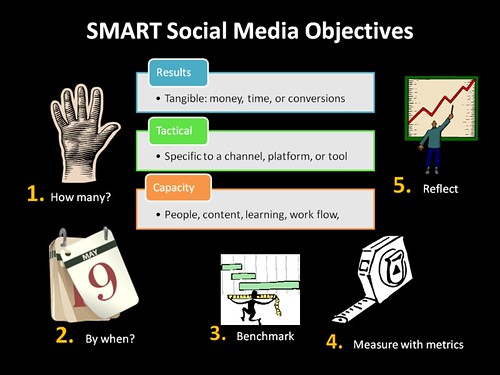
I’ve been working on a peer learning project with arts organizations called “Leveraging Social Media” based on the social media lab. There are two cohort groups, one working on strategic use of a single channel and a more advanced group working on an integrated strategy. With both, the process begins with setting SMART objectives and Kami Huyse points out why this is important.
Using SMART objectives for nonprofit communications strategies is not new idea. Spitfire’s useful SMART chart planning tool has been used by many nonprofits and was adapted for social media for nonprofits by NTEN’s WeAreMedia project several years ago.
SMART Objectives are specific, measurable, attainable, relevant, and timely objectives. The Aspen Institute’s Nonprofit Advocacy Campaign guide points out they come in three flavors:
Tactical: Tools and Techniques
Results: Money, time, or other tangible tesult that can be converted
Capacity: People, content, work flow, learning
The process includes beginning with identifying intent. Next, make it specific by adding a number, percentage, increase/decrease and a date. Some nonprofits find it hard to do because it takes hitting the pause button. Also, there may be a feeling that one is getting “graded” if they don’t make the deadline or hit the target number. SMART objectives can be revised along the way.
Some struggle to find an attainable number. Benchmarking comparing your organization’s past performance to itself or doing a formal or informal analysis of peer organizations can help. It also helps to break down your goal into monthly or quarterly benchmarks.
It is also important to think about what specific metrics are needed to measure along the way. Often, there is too much data collected and not enough sense-making of it. Many organizations think more data is better. It is best to concentrate on the one or two data points that will help guide improvements and demonstrate results. With social media as with communications strategies, the data points are those that will help measure: awareness, attitudes, actions, or behavior change.
Finally, allocating time for a reflection about what worked, what didn’t based on an analysis of the data is critical. Many nonprofits have not institutionalized this approach. Unfortunately, there is a goldmine of learning lost about lead to success or how to improve results next time around.
Here’s a summary of 25 SMART social media objectives from Leveraging Social Media project with arts organizations.
Results
Increase website traffic by 25% by adding social media content starting posting by November 1, 2012.
Acquire 100 new donors through Facebook Causes by June 30, 2012
Increase email list sign ups through social media channels by 500 names by June 30, 2012
Increase the number of gallery visitors who purchase (in person or online) by 20% by June 30, 2012
Increase online and print mentions by 25% by June 30, 2012
Increase enrollment in classes and workshops by 50% by June 30, 2012
Increase exhibition visitors by 15% by June 30, 2012
Tactical
Increase audience connections through Facebook to 1000 by June 1, 2012.
Increase our month to month Post Feedback on Facebook by 25% on average.
Increase mentions by 20% on Twitter before, during, and after performances for 2011
Increase likes and comments with fans on Facebook to 3 comments per post by June 30, 2012
Increase views on YouTube Channel by 50% by January, 2012
Increase number of retweets and @replies on Twitter by 20% by September, 30, 2011
Recruit 40 organizations to join our LinkedIn organization page by June 30, 2012
Increase web site traffic from Facebook by 20% by September 30, 2012
Utilize Facebook to increase Festival attendance and online program views by 5% by September 2011
Identify top 25 influencers on Twitter to build relationships to help blog, repost, and spread the word about online program by September, 30, 2012
Increase the age/ethnicity/gender/income/geographic of Facebook fans by 20% by June 30, 2012
Capacity
Create video trailers for all productions garnering an average of 100 views per trailer for the 2011-2012 programs.
Integrate social media across organization staff and departments to use it reach goals by 2012
Conduct an audience survey to determine where to expand, grow, and diversify social media presence for 2012
Create one video per month to tell stories about the impact of our organization by January, 2012.
Recruit 40 organization
Staff members in membership, fundraising, communications, and marketing departments will use social media tools to engage audiences on Facebook page 3 times per week.
Conduct surveys at the end of every class and workshop to gather important audience social media usage data and experience with program by June 2012
Enhance visual storytelling capacity and diversify type of content shared with a goal increasing videos by 10%, photos by 20% photographic and text that stimulates comments by 20% by August 1, 2012
Create a presence and support active fans on social fundraisings Jumo, Crowdrise, and Change.org by September 30, 2012
Create a system to collect, aggregate, and share user generated content on social media by audiences by September 30, 2012
What if we stepped away from the process of checking off items on our to do list, and spent a little bit of time charting impact of our nonprofit’s social media use? What if we made sure the process for identifying SMART objectives included capacity building, measurement, and reflection?
What is your organization’s SMART social media objectives? How did you determine it? How will you measure them along the way?
Beth Kanter is a consultant, author, influencer. virtual trainer & nonprofit innovator in digital transformation & workplace wellbeing.
